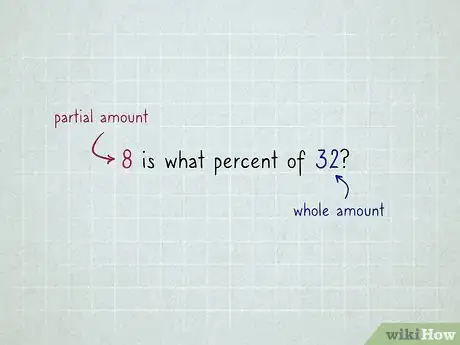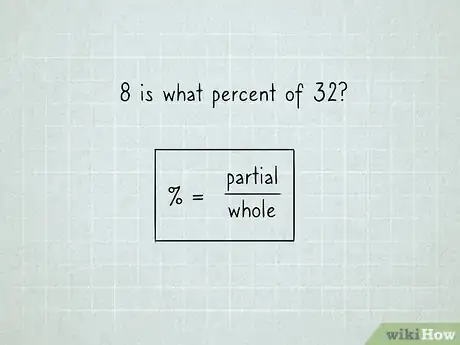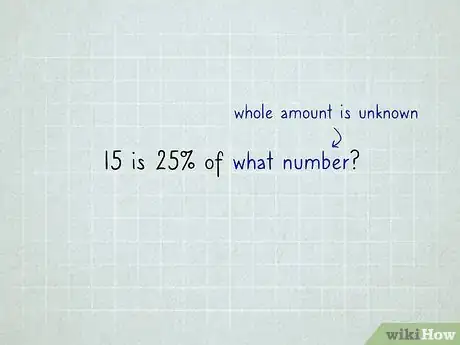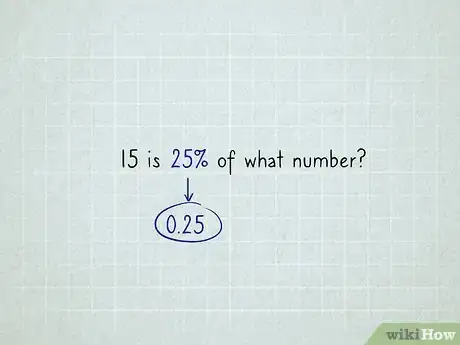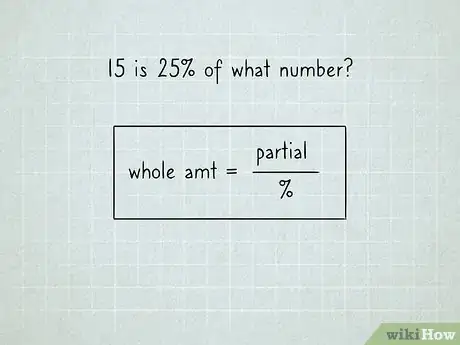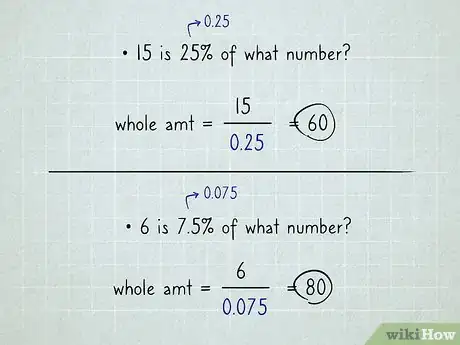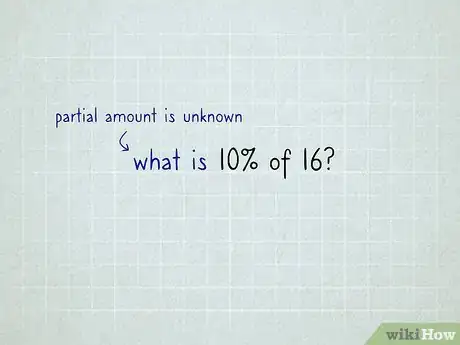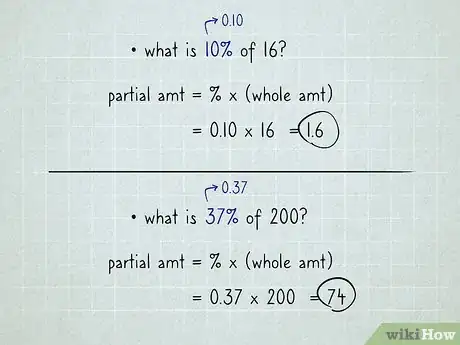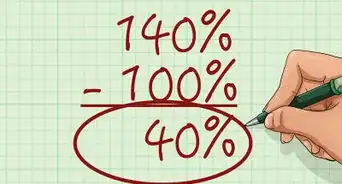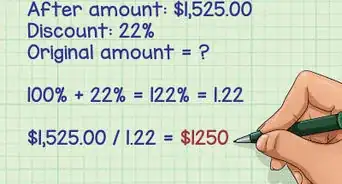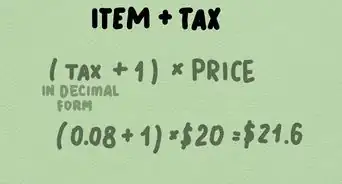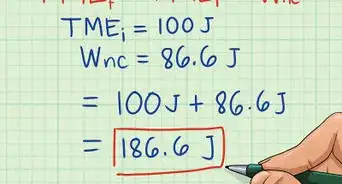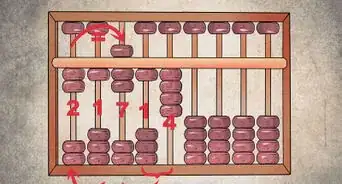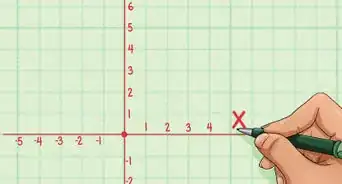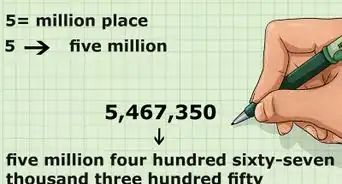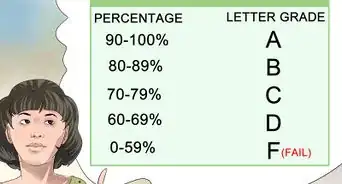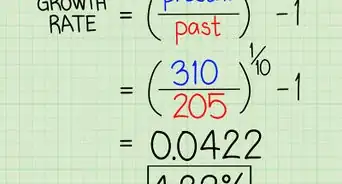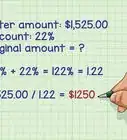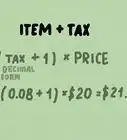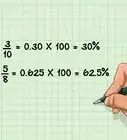This article was co-authored by David Jia. David Jia is an Academic Tutor and the Founder of LA Math Tutoring, a private tutoring company based in Los Angeles, California. With over 10 years of teaching experience, David works with students of all ages and grades in various subjects, as well as college admissions counseling and test preparation for the SAT, ACT, ISEE, and more. After attaining a perfect 800 math score and a 690 English score on the SAT, David was awarded the Dickinson Scholarship from the University of Miami, where he graduated with a Bachelor’s degree in Business Administration. Additionally, David has worked as an instructor for online videos for textbook companies such as Larson Texts, Big Ideas Learning, and Big Ideas Math.
This article has been viewed 295,047 times.
The first thing to understand is that there are two major categories of percentage problems: straight comparison questions (such as, "35 is 5% of what number?") and increase/decrease questions (like, "if a blouse that cost $45 originally is on sale at 20% off, what is the new price?). The increase/ decrease kind are complicated enough to require a separate Wikihow article, so let's focus on just the straight comparison for right now.
The other thing to know is that there are two major approaches to these questions. One is based on an equation involving decimals, and the other relies on proportions. I'm going to stick with the method that's based on the decimal equation, which is: % x (whole amount) = (partial amount). This equation can be rearranged like this: % = (partial amt) / (whole amt). It can also be written like this: (whole amt) = (partial amt) / %. Which arrangement you need depends on which kind of problem you have.
The Place to Start
Your first task is to figure out what kind of problem is in front of you. In a straight comparison situation, there are three styles of problems. The first style is the "no percent" question. Those would sound like: "what percent of 25 is 16?" or "8 is what percent of 32?". The second style is the "no entire amount" question. Those would be phrased like: "15 is 6% of what number?" or "78% of what number is 20?". The third style is the "no partial amount" question, which would sound like: "What is 52% of 49?" or "14% of 225 is how much?"
Steps
Solving an "Unknown Percent" Question
If you do not see a number marked by a % (or possibly the word "percent"), then this is almost certainly the "no percent" type of question.
-
1Decide which of the other numbers is the "whole amount" and which is the "partial amount". For example, a problem that says "8 is what percent of 32?" indicates that the 32 is the whole amount and the 8 is the partial. What tips this off: the 8 connects directly to the "is", while the 32 connects directly to the "of".
-
2Use the equation % = (partial)/(whole). So on the calculator,[1] punch in the partial amount, hit divide, enter the whole, and hit equals.[2]Advertisement
-
3This will give you a decimal, which you convert into a percentage by moving the decimal point two places to the right.[3]
- Example: "8 is what percent of 32?". Take 8, divide by 32, hit equals; get 0.25; convert that to 25%.
- Example: "what percent of 25 is 16?". Enter 16, divide by 25, hit equals; get 0.64; convert to 64%.
- Example: "what percent of 12 is 45?". Enter 45, divide by 12, hit equals; get 3.75; convert to 375%. (Answers larger than 100%, while rare, are acceptable).
- Example: "9 is what percent of 250?". Enter 9, divide by 250, hit equals; get 0.036; convert to 3.6%.
Solving an "Unknown Entire Amount" Problem
Let's say you have a percent. You now need to decide if the question is the "no whole amount" style or the "unknown partial amount" style. This is a trickier call to make and much depends on the context of the question.
-
1Look for the markers "is" and "of" and "what". "Is" tends to be associated with the partial amount, while "of" is paired with the entire amount. The word "what" indicates the unknown.[4]
- Example: A question says, "what is 10% of 16?" The phrase "what is" indicates that the partial amount is unknown. The phrase "of 16" indicates that 16 is the whole amount. This is an "unknown partial amount" problem.
- Example: A question says, "15 is 25% of what number?" The phrase "of what" means that the entire amount is unknown, but the phrase "15 is" shows that 15 is the partial amount. This would be an "unknown entire amount" problem.
-
2Let's assume you have an "unknown entire amount" problem, like "15 is 25% of what number?". First of all, change the percent into a decimal --- 0.25 instead of 25%, 1.38 instead of 138%, 0.07 instead of 7%, etc.[5]
-
3Use the equation: (whole amt) = (partial) / %.
-
4Using your calculator, enter the partial amount, hit divide, enter the percentage decimal, and hit equals.[6]
- Example: "15 is 25% of what number?". Grab your calculator, enter 15, hit the divide key, enter 0.25, hit equals. The answer is 60. You're done. (Notice, it's just 60. Not 60%.)
- Example: "32% of what number is 16?". Enter 16, hit divide, enter 0.32, hit equals; the answer is 50.
- Example: "125% of what number is 80?". Enter 80, hit divide, enter 1.25, hit equals; the answer is 64.
- Example: "6 is 7.5% of what number?". Enter 6, hit divide, enter .075, hit equals; the answer is 80.
Solving an "Unknown Partial Amount" Problem
-
1Look for the "is", "of", and "what" (or possibly "how much"). If the "is" and the "what" are closely associated, like in the question "what is 10% of 16?", then you have a "no partial amount" problem.[7]
-
2Here's what to do: Change the percentage back to a decimal, so 32% is 0.32 and 75% is 0.75 and 150% is 1.5 and 6% is 0.06, and so forth.[8]
-
3Use the equation: % x (whole amt) = (partial amt). In other words, you multiply the percent with the entire amount.[9]
- Example: "what is 10% of 16?". Enter 0.10, hit multiply, enter 16, hit equals. The answer is 1.6 (notice, no % sign on the answer).
- Example: "230% of 40 is what?". Enter 2.3, hit multiply, enter 40, hit equals. The answer: 92.
- Example: "how much is 37% of 200?". Enter 0.37, hit multiply, enter 200, hit equals. Answer: 74.
Community Q&A
-
QuestionWhat exactly is a percentage?
 David JiaDavid Jia is an Academic Tutor and the Founder of LA Math Tutoring, a private tutoring company based in Los Angeles, California. With over 10 years of teaching experience, David works with students of all ages and grades in various subjects, as well as college admissions counseling and test preparation for the SAT, ACT, ISEE, and more. After attaining a perfect 800 math score and a 690 English score on the SAT, David was awarded the Dickinson Scholarship from the University of Miami, where he graduated with a Bachelor’s degree in Business Administration. Additionally, David has worked as an instructor for online videos for textbook companies such as Larson Texts, Big Ideas Learning, and Big Ideas Math.
David JiaDavid Jia is an Academic Tutor and the Founder of LA Math Tutoring, a private tutoring company based in Los Angeles, California. With over 10 years of teaching experience, David works with students of all ages and grades in various subjects, as well as college admissions counseling and test preparation for the SAT, ACT, ISEE, and more. After attaining a perfect 800 math score and a 690 English score on the SAT, David was awarded the Dickinson Scholarship from the University of Miami, where he graduated with a Bachelor’s degree in Business Administration. Additionally, David has worked as an instructor for online videos for textbook companies such as Larson Texts, Big Ideas Learning, and Big Ideas Math.
Academic Tutor Percentages are the same thing as fractions with 100 in the denominator. Percent literally means “of 100." Thirty-seven percent is just 37 over 100. You can also write it as a decimal: 0.37.
Percentages are the same thing as fractions with 100 in the denominator. Percent literally means “of 100." Thirty-seven percent is just 37 over 100. You can also write it as a decimal: 0.37. -
QuestionHow would you find 25% of 100 on a calculator?
 David JiaDavid Jia is an Academic Tutor and the Founder of LA Math Tutoring, a private tutoring company based in Los Angeles, California. With over 10 years of teaching experience, David works with students of all ages and grades in various subjects, as well as college admissions counseling and test preparation for the SAT, ACT, ISEE, and more. After attaining a perfect 800 math score and a 690 English score on the SAT, David was awarded the Dickinson Scholarship from the University of Miami, where he graduated with a Bachelor’s degree in Business Administration. Additionally, David has worked as an instructor for online videos for textbook companies such as Larson Texts, Big Ideas Learning, and Big Ideas Math.
David JiaDavid Jia is an Academic Tutor and the Founder of LA Math Tutoring, a private tutoring company based in Los Angeles, California. With over 10 years of teaching experience, David works with students of all ages and grades in various subjects, as well as college admissions counseling and test preparation for the SAT, ACT, ISEE, and more. After attaining a perfect 800 math score and a 690 English score on the SAT, David was awarded the Dickinson Scholarship from the University of Miami, where he graduated with a Bachelor’s degree in Business Administration. Additionally, David has worked as an instructor for online videos for textbook companies such as Larson Texts, Big Ideas Learning, and Big Ideas Math.
Academic Tutor First you would turn the percentage into a decimal. Twenty-five percent is the same as 0.25. Then, you would multiply the decimal by 100, which would give you 25. Therefore, 25 is 25% of 100.
First you would turn the percentage into a decimal. Twenty-five percent is the same as 0.25. Then, you would multiply the decimal by 100, which would give you 25. Therefore, 25 is 25% of 100. -
QuestionIf a number is increased from 32 to 64, what is the percentage increase?
 DonaganTop AnswererFirst find the increase, which is 64 - 32 = 32. Then divide the original number into the increase. That gives you a decimal number, which you would multiply by 100 to get a percentage. In this case, dividing 32 into 32 gives you 1, which when multiplied by 100 gives you 100%. In this specific case, the original number is half the final number, which means the increase was 100% (i.e., the original number was doubled).
DonaganTop AnswererFirst find the increase, which is 64 - 32 = 32. Then divide the original number into the increase. That gives you a decimal number, which you would multiply by 100 to get a percentage. In this case, dividing 32 into 32 gives you 1, which when multiplied by 100 gives you 100%. In this specific case, the original number is half the final number, which means the increase was 100% (i.e., the original number was doubled).
Warnings
- Most calculators have a percent key. Its purpose is to move the decimal point twice to the left, turning 35% into 0.35, and 325% into 3.25, and 6% into 0.06, and so on. I advise AGAINST using this key because I find that most of my students move the decimal point themselves, then hit the % key as well, and everything gets screwed up.⧼thumbs_response⧽
- The order of division is vitally important![10] In both of the kinds of questions that are solved with division, the partial amount goes into the calculator first.⧼thumbs_response⧽
Things You'll Need
- A calculator.
or a sheet of paper
References
- ↑ https://sciencing.com/work-out-percentage-using-calculator-7598661.html
- ↑ https://www.dummies.com/education/math/basic-math/how-to-calculate-percentages/
- ↑ https://www.montereyinstitute.org/courses/DevelopmentalMath/TEXTGROUP-1-8_RESOURCE/U05_L2_T1_text_container.html
- ↑ https://www.khanacademy.org/math/pre-algebra/pre-algebra-ratios-rates/pre-algebra-percent-word-problems/v/solving-percent-problems-3
- ↑ https://www.khanacademy.org/math/pre-algebra/pre-algebra-ratios-rates/pre-algebra-percent-word-problems/v/solving-percent-problems-3
- ↑ https://www.khanacademy.org/math/pre-algebra/pre-algebra-ratios-rates/pre-algebra-percent-word-problems/v/solving-percent-problems-3
- ↑ https://www.khanacademy.org/math/pre-algebra/pre-algebra-ratios-rates/pre-algebra-percent-problems/v/taking-a-percentage-example
- ↑ https://www.khanacademy.org/math/pre-algebra/pre-algebra-ratios-rates/pre-algebra-percent-problems/v/taking-a-percentage-example
- ↑ https://www.khanacademy.org/math/pre-algebra/pre-algebra-ratios-rates/pre-algebra-percent-problems/v/taking-a-percentage-example
About This Article
To work with percentages, start by identifying what type of problem you’re working with. For example, if you see the words “is,” “of,” and “what,” you’re likely trying to solve for an unknown entire amount. If the question asks “15 is 25% of what number?” first change the percent into a decimal, which means moving the decimal point two places to the left, of .25. Now, if you want to use a calculator, enter 15, hit the divide key, enter .25, hit the equals key, and you get 60. To learn how to solve for an unknown partial amount, keep reading!
